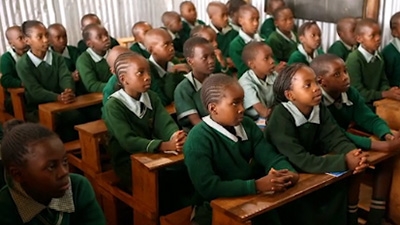Challenge
Despite important gains on the education Millennium Development Goal (MDG) targets (gender parity in primary and secondary enrollment reached nearly 97 percent in 2011 and primary school completion rates reached over 90 percent in 2011), well over 50 million primary school-age children are still out of school. Estimates show that about three quarters of those children live in countries afflicted by violence; regionally, more than half of them live in Africa and more than a fifth live in South Asia. Additionally, to varying degrees, educational progress has lagged because of indigenous, low-income, gender, or disability status in nearly all countries.
Improving learning outcomes requires strategic reforms and interventions at all levels of the education system. Major challenges in access to a meaningful education remain for the most disadvantaged populations, and there is a need to increase financing to close these gaps and to improve the quality of service provision through better policies and stronger institutions.
Solution
The Bank is one of the largest external education financiers for developing countries.
Since the MDGs were launched in 2000, the Bank has invested US$31.8 billion in education, including more than US$17.3 billion from the International Development Association (IDA). We help countries achieve their education goals through finance and knowledge services in the form of analytical work, policy advice, and technical assistance.
Education Strategy. The Bank Education Sector Strategy 2020, titled “Learning for All: Investing in People’s Knowledge and Skills to Promote Development,” responds to the challenges facing children of the 21st century by emphasizing the need to invest early, smartly, and for all. We encourage countries to jump-start learning through Early Childhood Development (ECD) programs, create a robust learning environment that measures learning and improves accountability, and build skills for a productive workforce.
Systems Approach for Better Education Results (SABER). SABER tools assist countries to conduct a thorough inventory of their education policies and institutions based on global best practices. SABER analyzes the quality of these policies and institutions and provides stakeholders with a tool for effective policy dialogue. It fills a critical gap in worldwide policy data and knowledge on what matters most in improving the quality of education.
Support for Millennium Development Goals (MDGs). In September 2012, World Bank Group President Jim Yong Kim reaffirmed the Bank's 2010 MDG Summit pledge to commit an additional US$750 million in financing for basic education over five years (2011-2015) from IDA to help the poorest countries accelerate progress toward the 2015 MDGs for education. As of April 1, 2014, the Bank has provided an additional US$939 million in IDA support for basic education, exceeding its pledge by 25 percent ahead of schedule.
Results
Bank assistance has helped contribute to the following global achievements in education:
- Global primary school completion rates reached 91 percent in 2011, up from 81 percent in 1999.
- Net primary enrollment rose to 89 percent in 2011, up from 82 percent in 1999.
- Gender parity in primary and secondary enrollment reached nearly 97 percent in 2011.
- Between 1999 and 2011, the total number of out-of-school children worldwide declined from 108 million to 57 million, 31 million of whom are girls, with the total falling by more than two thirds in South Asia.
- All regions of the world increased pre-primary enrollments between 1999 and 2011, with South Asia more than doubling pre-primary enrollment from 22 percent to 50 percent over the same period.
- Support to national education initiatives has contributed the following country results:
- In Indonesia, more than 500,000 children aged 0-6 in poor, hard-to-reach districts received early childhood education between 2007 and 2013.
- In Djibouti, increased access to primary school by adding over 100 classrooms in both urban and rural areas benefited more than 7,000 children, including 3,300 girls (2005-2011).
- In Pakistan’s Sindh province, the female-male primary net enrollment in rural areas rose from 61 percent in 2007 to 72 percent in 2011.
- In Tanzania, primary completion rate increased by 21 percent for boys and 31 percent for girls between 2005 and 2012.
- In Bangladesh, 790,000 out-of-school children, more than half of them girls, received “second chance” primary education between 2004 and 2012.
- In Haiti, 1,000 adolescent girls received training in non-technical and soft-skills between 2012 and 2013 to facilitate their school-to-work transition and improve their employment and earnings potential.
SABER influence on policy dialogue. To date, SABER tools have analyzed more than 100 countries and are informing investments in education at all levels, from pre-primary to tertiary education and workforce development. In Bulgaria, Bank staff worked with government counterparts, and a local NGO heavily involved in teacher issues, to map the teachers’ policy framework, allowing a deeper analysis informed by international good practice. In Angola, SABER helped government officials set priorities to strengthen the country’s student assessment system, and also underlined the need for trained staff and stable funding to underpin future assessment reforms.

